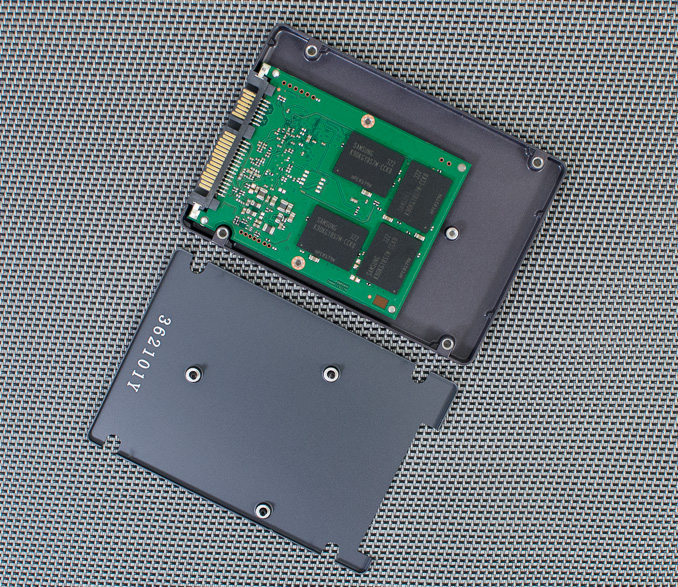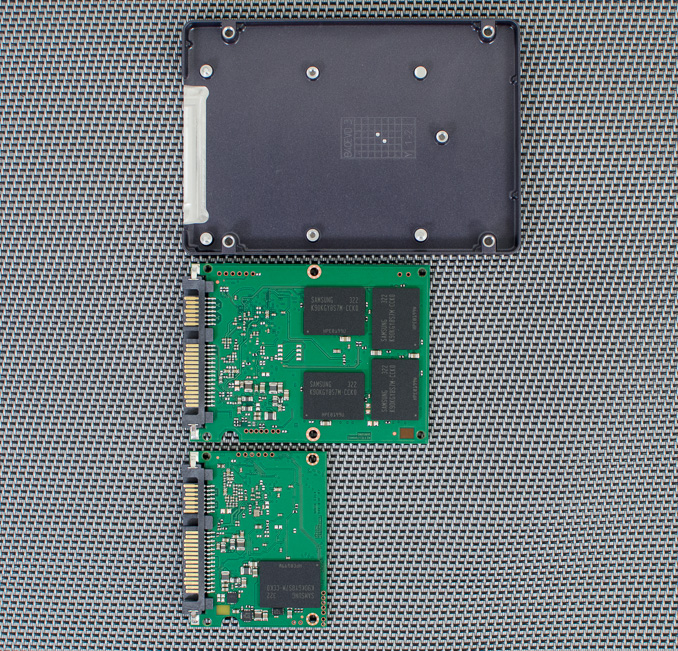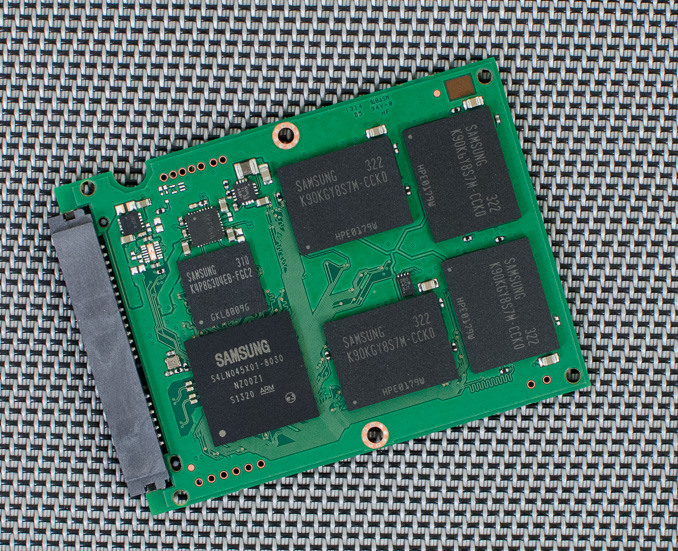Samsung SSD 840 EVO Review: 120GB, 250GB, 500GB, 750GB & 1TB Models Tested
by Anand Lal Shimpi on July 25, 2013 1:53 PM EST- Posted in
- Storage
- SSDs
- Samsung
- TLC
- Samsung SSD 840
Inside the Drives & Spare Area
The EVO is offered in a single form factor - 2.5" at a 7mm thickness. There are three torx (T5) screws that hold the chassis together, removing them gets you a look at the EVO's very simple internals. Surprisingly enough there's no thermal pad between Samsung's MEX controller and the chassis.
Samsung, like Intel, does a great job of reducing the number of screws and simplifying the assembly of its drives. I would prefer if Samsung didn't insist on using torx screws to hold the chassis together but I'm sure it does have some impact on reducing returns. There's also growing concern of counterfit SSDs which I guess screw choice could somewhat address.
There are two PCB sizes used in the EVO lineup, neither of which occupies the full volume of the 2.5"/7mm chassis. The 120 and 250GB drives use the smallest PCB, while the other drives use the larger layout. The larger PCB has room for 8 NAND packages, while the half length PCB can accommodate two. Each of the NAND packages can hold up to 8 x 128Gbit 19nm TLC die.
To deal with the realities of TLC, Samsung sets aside more of the drive for use as spare area on the EVO than it does on its MLC Pro line. Due to TurboWrite however, the percentage is actually a bit less than it was on last year's 840.
| Samsung SSD 840 EVO Memory | |||||||
| Advertised Capacity | 120GB | 250GB | 500GB | 750GB | 1TB | ||
| DRAM Size | 256MB LPDDR2-1066 | 512MB LPDDR2-1066 | 512MB LPDDR2-1066 | 1GB LPDDR2-1066 | 1GB LPDDR2-1066 | ||
| # of NAND Packages | 2 | 2 | 4 | 8 | 8 | ||
| # of NAND die per Package | 4 | 8 | 8 | 4 | 8 | ||
| NAND Capacity per Package | 64 GiB | 128 GiB | 128 GiB | 96 GiB | 128 GiB | ||
| Total NAND | 128 GiB | 256 GiB | 512 GiB | 768 GiB | 1024 GiB | ||
| Spare Area | 12.7% | 9.05% | 9.05% | 9.05% | 9.05% | ||
I've tossed internal shots of all of the EVO lineup into the gallery below:



















137 Comments
View All Comments
halbhh2 - Saturday, July 27, 2013 - link
Exactly. I found that even moving up from 8GB to 16GB had a great effect for me with an old Samsung F3 hard drive. The difference: after just 30 minutes from boot, loading an often used program like iTunes (for podcasts) was very similar to the speed on my laptop which has an 830 SSD and only 4GB. Both load in about 4 seconds, and the 16GB desktop loads so fast because it has had time to cache a lot of iTunes. Before the ram upgrade, that load time for iTunes on the desktop computer was about 14 seconds. Quite a difference due to windows 7 caching. The extra improvement I'd get from installing an SSD onto the desktop computer now would be modest, since I usually only need to reboot once or twice in a week. Still, the sweet spot of price/performance for me is approaching, probably around $60-$70, and that won't be long.Klimax - Sunday, July 28, 2013 - link
It's in wrong place. Unlike OS level caching (at least in Windows), which is in cooperation between memory manager, cache manager and file system driver, this is too low in the chain and sees only requests but nothing else and also takes memory from OS and takes too few.Coup27 - Thursday, July 25, 2013 - link
Typo: "although I wouldn't recommend deploying the EVO in a write heavy serve Microsoft's eDrive standard isn't supported at launch"Excellent article. Samsung continue to push SSDs and I'm really excited about RAPID. Is the 840 Pro due for a successor any time soon? I am selling my current ATX Sandy Bridge + 830 and getting a mITX Haswell + (840 Pro?) and want the fastest Samsung consumer SSD available and I'd be gutted to buy an 840 Pro to see it's successor released a few weeks later.
vLsL2VnDmWjoTByaVLxb - Thursday, July 25, 2013 - link
Another typo last page:"Even though its performnace wasn't class leading, it was honestly good enough to make the recommendation a no-brainer. "
JDG1980 - Thursday, July 25, 2013 - link
Will there be an 840 EVO Pro coming out later? To me, TLC is still a deal-breaker.By the way, what happens if power goes out during a TurboWrite (before the data has been written to the normal storage space)? Does this result in data loss, or, worse, bricking? I'd suspect Samsung at least avoided the latter, but I'd like to see some confirmation on this.
sherlockwing - Thursday, July 25, 2013 - link
I guess you didn't read the Endurance part of the review? Even if you write 100GiB a day all of those drives last longer than their warranty( 3 years), that's more than enough endurance.Coup27 - Thursday, July 25, 2013 - link
Some people just don't want to accept the facts. TLC could get to 99.9% of MLC endurance and people would still want MLC. I've been deploying 840's in a light duty enterprise environment and they've been fine. The only reason I use MLC at home is because I want the absolute fastest performance and I can afford it, not that I actually need it.Oxford Guy - Thursday, July 25, 2013 - link
The SanDisk Extreme 240 was just on sale for $150. TLC NAND still seems like a solution in need of a problem.Spunjji - Friday, July 26, 2013 - link
You can approach TLC pricing with an MLC drive in a sale, but the fact remains that when it comes to actual sustainable production pricing TLC NAND has a 50% density (and thus manufacturing cost advantage) over MLC. Given that NAND price determines drive cost and drive costs are the primary barrier of entry to SSDs, I'm fairly sure it has a problem to solve.FWIW I have not seen any drive touch the 120GB 840's price here in the UK, on sale or otherwise.
Oxford Guy - Friday, July 26, 2013 - link
However, there is also the problem of increasing latency and lifespan from node shrinkage.